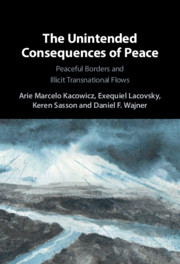Book contents
- The Unintended Consequences of Peace
- The Unintended Consequences of Peace
- Copyright page
- Dedication
- Contents
- Tables
- Preface
- Abbreviations
- 1 The Reality of Peaceful Borders and Illicit Transnational Flows
- 2 A Framework to Explain the Reality of Peaceful Borders and Illicit Transnational Flows
- 3 The Americas: A General View
- 4 The Americas: From the US-Canadian Border to the Tri-Border Area of South America
- 5 Europe: The Schengen Regime and the Western Balkan Borders
- 6 A Triangle of Peace in the Middle East: The Israeli–Egyptian and Israeli–Jordanian Borders
- 7 The Southern African Borders in the Postapartheid Era
- 8 ASEAN and the Southeast Asian Borders
- 9 Comparisons, Policy Recommendations, and Conclusions
- References
- Index
6 - A Triangle of Peace in the Middle East: The Israeli–Egyptian and Israeli–Jordanian Borders
Published online by Cambridge University Press: 11 June 2021
- The Unintended Consequences of Peace
- The Unintended Consequences of Peace
- Copyright page
- Dedication
- Contents
- Tables
- Preface
- Abbreviations
- 1 The Reality of Peaceful Borders and Illicit Transnational Flows
- 2 A Framework to Explain the Reality of Peaceful Borders and Illicit Transnational Flows
- 3 The Americas: A General View
- 4 The Americas: From the US-Canadian Border to the Tri-Border Area of South America
- 5 Europe: The Schengen Regime and the Western Balkan Borders
- 6 A Triangle of Peace in the Middle East: The Israeli–Egyptian and Israeli–Jordanian Borders
- 7 The Southern African Borders in the Postapartheid Era
- 8 ASEAN and the Southeast Asian Borders
- 9 Comparisons, Policy Recommendations, and Conclusions
- References
- Index
Summary
In this chapter, we examine what we call the triangle of peace in the Middle East, with reference to the peaceful international borders established upon the completion of peace treaties between Egypt and Israel on March 26, 1979, and between Israel and Jordan on October 26, 1994. In both cases, we show that international peace, especially in the case of Israel-Egypt, has been a permissive condition for the occurrence and proliferation of illicit transnational flows, including transnational crime and terrorism.Yet, we explain the variance between the two cases with reference to the three variables assessed throughout the book: the degree of physical and institutional openness of the peaceful borders; the degree of governance and institutional strength of the bordering states; and the prevalent socioeconomic conditions of the neighboring states. The Egyptian-Israeli case has registered significant instances of transnational crime and terrorism, whereas the Israeli-Jordanian dyad is almost a non-case, except for drugs trafficking. Their variance is explained in geopolitical terms, governance, the presence or absence of buffer zones, and the dominance of the security discourse.
Keywords
- Type
- Chapter
- Information
- The Unintended Consequences of PeacePeaceful Borders and Illicit Transnational Flows, pp. 156 - 180Publisher: Cambridge University PressPrint publication year: 2021

